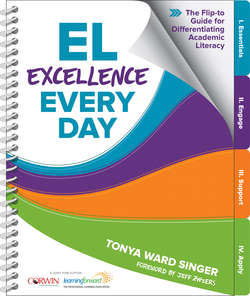Читать книгу EL Excellence Every Day - Tonya Ward Singer - Страница 37
На сайте Литреса книга снята с продажи.
2. Make Connections to Students’ Life Experiences, Culture, and Values
ОглавлениеGet to know what your students love and value within and beyond school. Use a getting-to-know-you survey, peer discussions, and/or informal interviews to get to know all students in your class. Open-ended questions such as the following are great for getting insight into students’ interests and values:
What do you like to do for fun outside of school?
What do you do with your family?
If you could only save one item from your home, what would it be? Why? (For a rich getting-to-know-you project, have students bring in an item or photo of an item and tell the story of why it matters.)
Imagine you accomplish something amazing (e.g., win a competition or create something incredible). Would you prefer to accomplish this by yourself or with a team? Why?
Ask questions and watch your students to learn how they experience and understand the world. What motivates them? What makes them proud? What makes them uncomfortable or angry? What makes them comfortable? What brings them joy? These universal questions apply to all students, not just ELs, and open possibilities to learn more deeply how students think about themselves and their experiences in and beyond school.
Seek to understand culture beyond heroes and holidays. To understand and build on cultural differences, look beyond surface aspects of culture (e.g., celebrations, music, and food) that are easy to see, to understand what Hammond (2015) calls shallow culture and deep culture. Shallow culture includes our unspoken rules of what feels “normal” in our communication styles and relationships (e.g., concepts of time, notions of personal space, and ways of handling emotion). Deep culture includes our unconscious beliefs and values such as our notions of fairness or preferences for cooperation or competition (Hammond, 2015). To understand and value the shallow and deep culture of others, it helps to first reflect on what our own culture may be.
The unspoken aspects of our own culture are often invisible to us, especially when we share the same culture as our environment. I’ve learned the most about my own culture when I’ve been in cross-cultural situations that challenge my own sense of “normal.” For example, I didn’t think much about personal space as an aspect of culture until I lived in China for a year and noticed how incredibly uncomfortable I felt in bus lines. Waiting to board a bus, I feel like the strangers around me were incredibly rude to crowd me, press up against me, and even step in front of me to jockey for position to board the bus. Based on my cultural norm, the lack of personal space people gave me felt “rude,” but there was no rude or malicious intent. People of all ages were just doing what people did to get on the bus, not just with me but also with everyone. What was comfortable for people used to the culture wasn’t comfortable to me based on my own cultural background. I did learn over time to adapt so I could flow onto buses with the crowd—but I never did feel fully comfortable until I boarded and reestablished the amount of personal space that felt right to me.
The following are examples of unspoken aspects of culture with some reflection questions you can use to think about your own cultural values and norms or to reflect on possible differences among you and colleagues or students:
Personal Space: How much distance feels comfortable between you and a friend when you are talking? What distance feels comfortable when you walk side by side? What distance is most comfortable between strangers when standing in a line?
Concept of Time: When you agree to meet a friend at a certain time, how important is it to arrive by that exact number on the clock? If someone else is ten minutes late, how do you feel? If you are ten minutes late, how do you feel? What’s more offensive: someone arriving late or someone getting upset because you are a few minutes late?
Individualism–Collectivism: Do you feel most comfortable working alone or with a team? Why? How do you feel when you see one person take all the credit for a group project? How do you feel when you see a team get equal credit when some individuals did most of the work?
These questions are not exhaustive but examples of questions to help you and students think about culture beyond holidays and food. Seek to understand the unspoken and invisible aspects of students’ cultures so that you can connect across cultural differences in ways that build trust. Know your own culture so you can be intentional to see beyond your own sense of normal to create space for different cultural orientations in your classroom. For example, if you are a teacher in the United States, recognize that the United States is one of the most individualistic cultures in the world and that making learning more collaborative is one powerful way to be a culturally responsive teacher (Hammond, 2015; Hofstede, Hofstede, & Minkov, 2010).
“Our diverse students’ knowledge and linguistic abilities are assets that should be integrated into how and what we teach.”
—Jeff Zwiers (2008, p. 12)
Beyond beginning-of-year surveys and getting-to-know-you activities, structure collaborative conversations daily in your teaching routines that invite not one right answer but diverse perspectives about the texts students read and concepts you teach. The more you invite students to build their voices in your classroom, the more you learn about their interests and values and the better equipped you become to connect to students’ backgrounds in your teaching. Flip to Chapter 3 for peer conversation strategies and Chapter 5 for strategies to connect to students’ prior knowledge and experience. Every chapter in Section IV will help you apply these strategies in synthesis to meet literacy goals.
